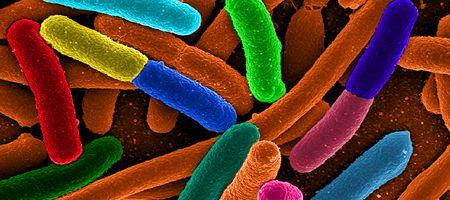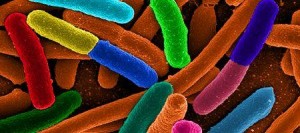In Michael Crichton’s sci-fi thriller, “Prey” he described self-organizing nano-sized biological computers breaking out of a high-level security lab and taking over the world. Is this our future or is this pure fantasy?
The search for the ultimate medium upon which to create artificial intelligence appears to be biological. The building blocks of life on Earth all contain DNA. This complex molecule can be found in every living thing on the planet. What if DNA replaced silicon chips? In 2003, scientists in Israel built a computer running on DNA. It could perform 330 trillion operations per second, 100,000 times faster than silicon-based PCs. In addition the DNA computer contained no silicon or the metals and chemicals that make today’s computers quite toxic when recycled.
Using the building blocks of life for computing makes a lot of sense. After all life is really a bunch of biochemical nanocomputers that reside in the nuclei of cells. Our problem in creating biological computers based on DNA is quite simple. We need to be able to control how DNA is used. Right now we are struggling to turn that dream into a reality.
Why would a DNA-based computer be attractive? In previous discussions we talked about how today’s computer chips are approaching the limits of silicon as a medium. You can only pack so many transistors, resistors and capacitors on a silicon chip. A single DNA molecule residing in the nucleus of a cell is a biological powerhouse. A cubic centimeter of the stuff can store the equivalent of a trillion music CDs. A teaspoon has the capacity to equal 15,000 trillion computers. A pound can store more information than all the computers humans have ever built to this day. That’s incredible capability and that is one reason for making computers based on biology rather than silicon.
The other reason is related to energy. DNA computers don’t need a lot of energy to work. In fact they almost need nothing. Put a DNA computing molecule in the appropriate chemical soup and it feeds and supports itself expending less than one millionth of the energy required to run silicon chip technology.
So like the quantum computers we described previously, DNA-based computers are inherently green and far more compatible with our 21st century vision of environmental sustainability.
We can identify immediate application for DNA computers. The fact that they can be very tiny, molecular in size, and that they operate in a self-sustaining way in liquid environments, makes them ideal tools for medicine and the bio-pharmaceutical industry. Imagine molecular-sized computers that can operate inside a living cell to sense problems and correct them. DNA computers can be integrated into our bodies on permanent patrol, sensing changes in blood chemistry, enhancing our defenses against cancer, heart disease and other life threatening conditions.
How does DNA work as a computer. Every DNA molecule contains four sequenced nucleotides that are represented by the letters A, T, C, and G. A is for adenosine. T stands for thymine. C represents cytosine, and G is guanine. These Nucleotides are molecules that when joined together make up the structural units of DNA. Their order and sequence determines our genetic makeup.
In a DNA computer the sequencing of these nucleotides can mimic the control gates that we previously discussed. The sequencing can offer us a range of values that go beyond 0 and 1, very much like the kind of fuzzy logic that quantum computers are capable of using. A single strand of DNA could perform simultaneous calculations performed in parallel, solving problems in micro-seconds rather than the minutes and hours that today’s computing technology requires.
This massive parallel processing capability, performed by nano-sized computers, capable of operating without an electric cord attached, each performing specific tasks, each capable of communicating with others around them, sounds like the work of science fiction. But it is not.
Today’s researchers are creating gene-based computer programs that can be inserted into living cells to replicate. These genetic robots can generate engineered sequences of genetic material controlling the chemicals that our cells use to pass on genetic instructions as they replicate. Genetic robots could act like a permanent team of doctors always on call in your body, correcting problems as they occur.
Other scientists are attempting to marry biology and silicon, uniting living organisms with silicon chips. This research focuses on nerve cell-chip interactions. The potential represented by this fusion of the living with silicon is the creation of human-robot interfaces. Implant a silicon chip integrated with our nervous system and we can operate technology remotely with minimal training or just by thoughts. Recently a British researcher, Professor Kevin Warwick, demonstrated how this cybernetic symbiosis works in a four month experiment. He attached an implanted a computer chip to the main nerve in his arm and operated a robot on wheels remotely.
Ultimately we have the capability in this century to engineer a living organism. SAIC is a Fortune 500 company that is creating neural networks from living nerve cell tissue, a brain in a jar. It is not too much of a stretch to imagine creating a fully-integrated living biological computer which functions independently of its creators and replicates on its own.
There are very good reasons to pursue this line of research. The benefits include:
- Biological computers are energy efficient. Ultimately they can draw on energy resources from the chemistry that surrounds them.
- Biological computers have little negative environmental impact.
- Biological computers can be engineered in labs using genetic materials that are plentiful and self assembling.
- Biological computers have the capability to process information and solve problems at speeds no silicon-based computer can match.
- Biological computers provide infinite variability in form factor. They can be as small as a few molecules so that they can be inserted into a living being or they can be engineered to be a living being.
- Biological computers can self improve. They can do this the same way the mechanisms of evolution have impacted all life on Earth.
There are drawbacks to biological computing. One of them is that biological computers by their very nature are as prone to error as our own brains. As we described previously in research being done on neuromorphic chips, fuzzy logic, trial and error, exploring different solutions and finding shortcuts is the way our brain works. That is the way biological computers solve problems. So biology-based computing subjects its users to higher error rates than current silicon chip technology. Are we prepared as a society to accept computers that learn from their mistakes? What if the mistakes these computers make lead to loss of life?
The development of biological computing in this century will raise other fundamental questions related to the definition of life, the ethics of creating artificial intelligence that is self replicating, and ultimately the issue of what rights we as humans are prepared to provide any artificial intelligence that we create.

















As a whole your work is commendable. As you are aiming general readers a little more readability or what they say more brilliant narration is desirable. ‘When will computers become more human? – Part 3: The Evolution of Biological Computing’ is really interesting and dramatic, most of the information is new to me.
‘ And when he had opened the seventh seal, there was silence in heaven about the space of half an hour’
I think humankind is approaching the opening of seventh seal, you made me think like that. THANKS
prasad